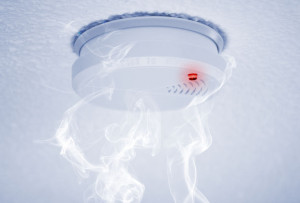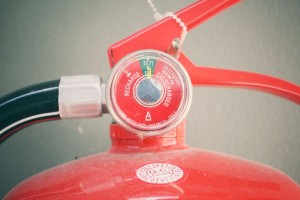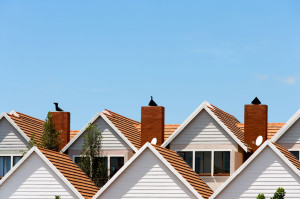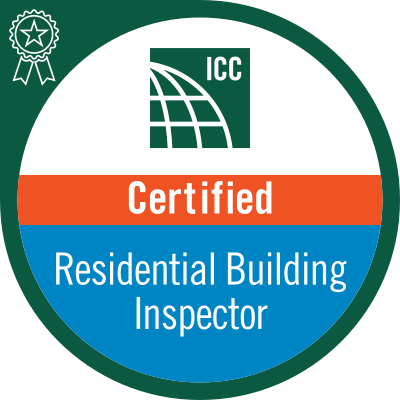A building’s central air-conditioning systems must be periodically inspected and maintained in order to function properly. While an annual inspection performed by a trained professional is recommended, homeowners can do a lot of the work themselves by following the tips offered here.
Clean the Exterior Condenser Unit and Components
The exterior condenser unit is the large box located on the side of the house that’s designed to push heat from the indoors to the outdoors. Inside of the box are coils of pipe that are surrounded by thousands of thin metal “fins” that allow the coils more surface area to exchange heat.
Follow these tips when cleaning the exterior condenser unit and its inner components — after turning off power to the unit, of course.
- Remove any leaves, spider webs and other debris from the unit’s exterior. Trim foliage back several feet from the unit to ensure proper air flow.
- Remove the cover grille to clean any debris from the unit’s interior. A garden hose can be helpful for this task.
- Straighten any bent fins with a tool called a fin comb.
- Add lubricating oil to the motor. Check your owner’s manual for specific instructions.
- Clean the evaporator coil and condenser coil at least once a year. When they collect dirt, they may not function properly.
Inspect the Condensate Drain Line
Condensate drain lines collect condensed water and drain it away from the unit. They’re located on the side of the inside fan unit. Sometimes there are two drain lines—a primary drain line that’s built into the unit, and a secondary drain line that can drain if the first line becomes blocked.
Homeowners can inspect the drain line by using the following tips, which take very little time and require no specialized tools:
- Inspect the drain line for obstructions, such as algae and debris. If the line becomes blocked, water will back up into the drain pan and overflow, potentially causing a safety hazard or water damage to your home.
- Make sure the hoses are secured and fit properly.
Clean the Air Filter
Air filters remove pollen, dust and other particles that would otherwise circulate indoors. Most filters are typically rectangular in shape and about 20 x 16 inches, and about 1 inch thick. They slide into the main ductwork near the inside fan unit. The filter should be periodically washed or replaced, depending on the manufacturer’s instructions. A dirty air filter will not only degrade the quality of the home’s indoor, but it will also strain the motor to work harder to move air through it, increasing energy costs and reducing energy efficiency. The filter should be replaced monthly during heavy use during the cooling seasons. You may need to change the filter more often if the air conditioner is in constant use, if any family members have respiratory problems, if you have pets with fur, and/or if it’s particularly dusty indoors.
Cover the Exterior Unit
When the cooling season is over, you should cover the exterior condenser unit in preparation for winter. If it isn’t being used, why expose it to the elements? This measure will prevent ice, leaves and dirt from entering the unit, which can harm components and require additional maintenance in the spring. A cover can be purchased, or you can make one yourself by taping together plastic trash bags. Be sure to turn the unit off before covering it.
Close the Air-Distribution Registers
Air-distribution registers are duct openings in ceilings, walls and floors where cold air enters the room. They should be closed after the cooling season ends in order to keep warm air from back-flowing out of the room during the warming season. Pests and dust will also be unable to enter the ducts during the winter if the registers are closed. These vents can typically be opened or closed with an adjacent lever or wheel. Remember to open the registers in the spring before the cooling season starts. Also, make sure they’re not blocked by drapes, carpeting or furniture.
In addition, homeowners should practice the following strategies in order to keep their central air-conditioning systems running properly:
- Have the air-conditioning system inspected by a professional each year before the start of the cooling season.
- Reduce stress on the air-conditioning system by enhancing your home’s energy efficiency. Switch from incandescent lights to compact fluorescents, for instance, which produce less heat.
Evaporative Coolers
What is an evaporative cooler?
An evaporative cooler, also known as a swamp cooler, wet-air cooler, and desert cooler, is a device designed to cool air via the evaporation of water. This is a natural and energy-efficient way to achieve a comfortable indoor temperature. An evaporative cooler cools indoor air by drawing outdoor air into the unit and passing it over pads that have been saturated with water from a reservoir in the unit. The water evaporates into the air as it passes over the pads, and the result is a 15° to 40° drop in temperature. The cooled air is then directed through interior areas where a lowered temperature is desired, forcing warm air outside through open windows. Because of this, evaporative coolers steadily circulate fresh air through the interior, unlike air conditioners, which circulate the same air over and over again. They also cost far less than air conditioners and use around a quarter of the energy, making them a very efficient alternative.
How does evaporation work to lower air temperature?
This process can be observed naturally near a waterfall, lake, river or ocean. When dry air passes over water, the air absorbs some of the water. The air temperature drops because the temperature and vapor pressure of the water and air attempt to equalize. Until the air is saturated and unable to hold any more water, liquid water molecules turn to gas in the air, a process that uses energy to change the physical state of the water. Heat moves from the higher temperature of the air to the lower temperature of the water, which causes the air to cool.
How an Evaporative Cooler Works
An evaporative cooler is basically a large fan with pads, moistened by water, which are located in front of the fan. The fan pulls the hot, outside air inside, and the air is cooled after passing over the wet pads. The pads are usually made from wood, wool or fiber, though some plastics and melamine paper are now also used to make cooler pads. However, wood absorbs some of the water, which allows it to cool the passing air to a lower temperature than some synthetic materials. The thickness of the pad also plays a part in the cooling efficiency because a larger pad allows longer air contact, so a 10-inch pad is more efficient than a 4-inch pad. The pads need to be replaced every season or two, but they are fairly inexpensive.
Small water distribution lines wet the top of the pads, which become soaked. Once the water trickles through them, collecting at the bottom in a sump, a small re-circulating pump sends the water back to the top of the pads to soak them again. When enough water is lost through the evaporation process, a float valve adds water to the sump so that the pads can continue to be soaked. Under normal conditions, a cooler may use between 3 and 15 gallons of water per day.
Because evaporative cooling takes air from the outdoors, cools it, and circulates it indoors, there must be a way for the warm air inside to escape when it is displaced by the incoming cool air. By leaving doors and windows open strategically, it is possible to direct the path of incoming cool air to areas where it is needed most. Even smaller units can be effective for larger areas when used in this way. Many types of cooling units are currently manufactured, including small units for installation in windows, as well as large units meant to be installed centrally to blow air through ductwork and into individual rooms.
Evaporative Cooling vs. Air Conditioners
The most important factor to keep in mind when determining whether an evaporative cooler can be utilized effectively in a particular situation is the moisture content of the outside air. Since the air will not hold additional moisture once it reaches its saturation point, no drop in temperature will occur through evaporation if the air is already saturated. Because of this, evaporative cooling cannot be used effectively in wet or humid climates. Meanwhile, in areas where the air is hot but humidity is low, the coolers can be used as a cost-effective and energy-efficient alternative to air conditioners. Such areas in the U.S. include Colorado, Utah, New Mexico, Arizona, northern Texas, and some parts of California.
Here are some advantages and disadvantages of using evaporative cooling vs. traditional, phase-change air conditioners.
Advantages of Evaporative Coolers:
- Evaporative coolers are less expensive to install, estimated at about half the cost of refrigerated air conditioning.
- Operating costs are lower, as well. Power consumption, limited only to the fan and water pump, is estimated at one-fourth of that used for air conditioning.
- Low maintenance is also an advantage of evaporative coolers because the only mechanical parts in most units are the fan motor and water pump, which can be easily replaced or repaired at low cost.
- Ventilation is increased due to the air being constantly cycled through the cooler to the interior and back outside through open windows and doors.
- The increased humidity content in the interior air that results from evaporative cooling can be desirable in dry climates.
- The cooling pads, when properly maintained, act to filter air, removing contaminants as the cooled air enters the interior.
Disadvantages of Evaporative Coolers:
- High-humidity conditions will not allow the cooler to function effectively.
- Supplied air from the evaporative cooler is typically 80% to 90% relative humidity, which is sometimes not desirable for indoors, as it can acc
 elerate corrosion, shortening the life of electronic and other equipment, and/or simple be uncomfortable.
elerate corrosion, shortening the life of electronic and other equipment, and/or simple be uncomfortable.
- High humidity also causes condensation, which can become a problem with electrical equipment, old wood, paper and books, and develop into potential mold and mildew problems.
- Water must be constantly supplied to the pads. Water that has a high mineral content will eventually leave deposits on the pads and the interior of the cooler. The water supply line may also need to be protected from freezing and potentially bursting during the cold season.
- Odors and outdoor contaminants can be blown into the interior if sufficient filtering isn’t in place. Asthma sufferers may need to avoid environments whose evaporative coolers are poorly maintained.
Evaporative coolers can be less expensive and environmentally friendlier alternatives to traditional air conditioners, depending on the climate and other factors. Like any home system, homeowners should plan on becoming familiar with their evaporative cooler in order to maintain it seasonally.
Thermostats
Thermostats are devices designed to control the heating and cooling system in the home so that the air temperature remains comfortable. Homeowners should understand how thermostats operate, as well as the more common problems associated with them.
Thermostats can be manually controlled or set to activate automatically based on timers or room temperature readings. Most thermostats contain two meters: the “set” temperature that the thermostat is asking for, and the actual temperature. On a traditional dial-type thermostat, the user can increase the set temperature by rotating the dial clockwise, and lower it by rotating it counter-clockwise. Newer thermostats usually have digital displays, which can be used to adjust automated heating and cooling schedules.
Location
In order to avoid false or “ghost” readings, which will cause unnecessary furnace or air-conditioner cycling, the thermostat must be installed so that it correctly reads the room temperature.
The following locations may cause the thermostat to give false readings:
- near a heat source, such as a fireplace, hot water pipes, bright lights, direct sunlight, and electrical appliances that produce heat;
- in a drafty hallway, or near a window or exterior door that is left open often; and
- on an outside wall. Outside walls are affected too much by outside temperatures, which may make the thermostat “think” the air in the house is warmer or cooler than it really is.
Common Thermostat Problems and Solutions
- erratic operation or fluctuating temperature. This is often caused by poor pin connections between the thermostat and the backplate when the backplate is flexed against an uneven wall. To allow the backplate to flatten out, loosen the screws that attach the backplate to the wall, then snap the thermostat back onto the backplate.
- a thermostat that doesn’t respond to changes in room temperature. This can happen when there is air passing over the temperature sensor from a hole in the wall behind the thermostat, through which wires enter from the air-handling unit. To rectify this, insulate the hole behind the thermostat with fiber insulation, spray foam, or any other insulating material.
- a temperature reading that is inaccurate. A convenient way to test the temperature sensor is to tape a thermometer to the wall next to the thermostat and wait 15 minutes. A faulty thermometer needs to be recalibrated. Instructions for recalibration vary by manufacturer.
- loss of power. This may be caused by the following two situations:
- If the air handler powers the thermostat, check the circuit breaker meant for the air handler and make sure it has not tripped.
- If batteries power the thermostat, make sure they are lithium, not alkaline. Alkaline batteries will die rapidly or cause erratic thermostat operation.
Maintenance and Other Tips
- Give the thermostat’s interior a light dusting with a small, soft-bristle paintbrush. Canned air can also be used to blow off dust. Twist the screws to remove the cover. Be sure to clean the contacts, which are small metal plates within the unit. The wires coming from the transformer attach to the contacts. Do not touch any of the interior parts with your fingers.
- If the base is loose, re-tighten the screws. Check the wires coming from the transformer. If any corrosion is present, remove the wire from the contact and clean it. Use a wire stripper to remove the surrounding insulation, cut back the wire, and reconnect it.
- Make sure the terminal screws are tight.
- For wireless thermostats, make sure the model number of the thermostat matches the model number of the receiver. If the model numbers don’t match, the thermostat and receiver will not be compatible and won’t function properly together.
- Make sure that your thermostat has been set to the proper position for the season: cooling or heating. The air conditioner will not run with the switch set to “heating” and, conversely, the heating system won’t run if the thermostat has been set to “cooling.”
- Thermostats that contain a mercury switch must remain perfectly level or they may not control the temperature setting.
A Few Notes on Energy Savings
- Many people believe that furnaces work harder than normal to warm an area back up to a comfortable temperature, which will counteract energy savings gained from turning the thermostat down. This belief is a misconception that has been disproved by years of studies and research. Fuel is saved between the time the temperature is stabilized at the lower level and the next time heat is needed, while the fuel required to re-heat the space is roughly equal to the fuel saved while the building drops to a lower temperature.
- According to the U.S. Department of Energy, consumers can save 10% on their utility bills by setting their thermostat lower by 10° to 15° for eight hours. This can be easily accomplished with a programmable thermostat.
- Be careful not to set the thermostat so low in the winter that indoor plumbing pipes freeze, or so low during the summer that mold may be allowed to grow prompted by excess indoor humidity.
Programmable Thermostats
Using a programmable thermostat in the winter, you can automatically turn down your heat at night or when you’re not at home. In the summer, you can save money by automatically turning your air conditioner up at night or when you’re at work.
Using a programmable thermostat, you can adjust the times that the heating and air conditioner go on and off according to a preset schedule. As a result, the equipment doesn’t operate as much when you’re asleep or when the house (or a part of it) is empty. Programmable thermostats can store and repeat multiple daily settings (six or more temperature settings a day) that you can manually override without affecting the rest of the daily or weekly program.
Follow us on Facebook for weekly maintenance and safety tips. If you are buying a home in the beautiful Black Hills of South Dakota schedule your home inspection with Red Horse Home Inspection. Easily schedule online or call 605-490-2916. https://app.spectora.com/home-inspectors/copper-mountain-home-inspection-llc
 Have a little one in your house? You’ve likely did your fair share of child proofing in every room of your home. Unfortunately, there are a number of hazards in homes today that many parents do not realize pose a safety threat. What should you look out for? Here’s a look at some everyday items that are dangerous to children:
Have a little one in your house? You’ve likely did your fair share of child proofing in every room of your home. Unfortunately, there are a number of hazards in homes today that many parents do not realize pose a safety threat. What should you look out for? Here’s a look at some everyday items that are dangerous to children:
 elerate corrosion, shortening the life of electronic and other equipment, and/or simple be uncomfortable.
elerate corrosion, shortening the life of electronic and other equipment, and/or simple be uncomfortable.


 A new home is definitely a big reason to celebrate. What better way to mark the day than with a thoughtful housewarming gift? If you enjoy giving practical gifts, a fire extinguisher is an incredible choice for a new homeowner. Every homeowner should have one on each floor or area of their home. And many people forget to buy one. Moving into a new home? Put a fire extinguisher on the top of your shopping list.
A new home is definitely a big reason to celebrate. What better way to mark the day than with a thoughtful housewarming gift? If you enjoy giving practical gifts, a fire extinguisher is an incredible choice for a new homeowner. Every homeowner should have one on each floor or area of their home. And many people forget to buy one. Moving into a new home? Put a fire extinguisher on the top of your shopping list.
 Ready to make a move? Finding the right property can be a daunting task. In addition to selecting a design and a floor plan that you like, you also have to think about the condition the house is in.
Ready to make a move? Finding the right property can be a daunting task. In addition to selecting a design and a floor plan that you like, you also have to think about the condition the house is in. Moving into a new home is a happy — and hectic — time. There’s so much to do! Your to-do list is overflowing in the days and weeks after purchasing a home. That’s why we wanted to share with you two tasks that you’ll want to put at the top of your to-do list to help keep you and your family healthy and safe.
Moving into a new home is a happy — and hectic — time. There’s so much to do! Your to-do list is overflowing in the days and weeks after purchasing a home. That’s why we wanted to share with you two tasks that you’ll want to put at the top of your to-do list to help keep you and your family healthy and safe.

